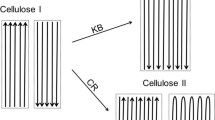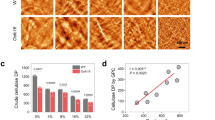Abstract
We have shown that the isolated cellulose binding domain of endoglucanase A (GenA) from the bacterium Cellulomonas fimi disrupts the structure of cellulose fibres and releases small particles but has no detectable hydrolytic activity. In contrast, the isolated catalytic domain of this enzyme does not disrupt the fibril structure but polishes the surface of the fibre concomitant with the release of reducing sugars.
This is a preview of subscription content, access via your institution
Access options
Subscribe to this journal
Receive 12 print issues and online access
$209.00 per year
only $17.42 per issue
Buy this article
- Purchase on Springer Link
- Instant access to full article PDF
Prices may be subject to local taxes which are calculated during checkout
Similar content being viewed by others
References
Ong, E., Greenwood, J.M., Gilkes, N.R., Kilburn, D.G., Miller, R.C., Jr. and Warren, R.A.J. 1989. The cellulose-binding domains of cellulases: tools for biotechnology. Trends Biotechnol. 7: 239–243.
Pilz, I., Schwarz, E., Kilburn, D.G., Gilkes, N.R., Miller, R.C. Jr. and Warren, R.A.J. 1990. The tertiary structure of a bacterial cellulase determined by small-angle X-ray scattering analysis. Biochem. J. 271: 277–280.
Warren, R.A.J., Beck, C.R., Gilkes, N.R., Kilburn, D.G., Langsford, M.L., Miller, R.C., Jr., O'Neill, G.P., Scheufens, M. and Wong, W.K.R. 1987. Sequence conservation and region shuffling in an endoglucanase and an exoglucanase from Cellulomonas fimi. Proteins. 1: 335–341.
Gilkes, N.R., Miller, R.C. Jr., Warren, R.A.J. and Kilburn, D.G. 1988. Precise excision of the cellulose binding domains from two Cellulomonas fimi cellulases by a homologous protease and the effect on catalysis. J. Biol. Chem. 263: 10401–10407.
Gilkes, N.R., Henrissat, B., Kilburn, D.G., Miller, R.C. Jr. and Warren, R.A.J. 1991. Domains in microbial β-l,4-glycanases: sequence conservation, function and enzyme families. Microbiol. Rev. 55: 305–315.
Klyosov, A.A. 1990. Trends in biochemistry and enzymology of cellulose degradation. Biochem. 29: 10577–10589.
Cheek, L. and Roussel, L. 1989. Mercerization of ramie: comparisons with flax and cotton. Part I: effects on physical, mechanical, and accessibility characteristics. Textile Res. J. 59: 478–483.
Reese, E.T., Sui, R.G.H. and Levinson, H.S. 1950. Biological degradation of soluble cellulose derivatives. J. Bacteriol. 59: 485–497.
Wood, T.M. 1989. Mechanisms of cellulose degradation by enzymes from aerobic and anaerobic fungi, p. 12–35. In: Enzyme Systems for Lignocellulose Degradation. Coughlan M. P. (Ed.). Elsevier Applied Science, New York.
Nevell, T.P. and Zeonian, S.H. 1985. Cellulose chemistry fundamentals, p. 15–29. In: Cellulose Chemistry and its Applications. Nevell, T. P. and Zeonian, S. H. (Eds.). John Wiley & Sons, New York.
Kolpak, F.J. and Blackwell, J. 1975. Deformation of cotton and bacterial cellulose microfibrils. Textile Res. J. 45: 568–572.
Blackwell, J. 1982. The macromolecular organization of cellulose and chitin, p. 403–428. In: Cellulose and Other Natural Polymer Systems. Biogenesis, Structure and Degradation. Brown, R. M. Jr. (Ed.). Plenum Press, New York.
Wood, T.M. 1991. Fungal cellulases, 491–533. In: Biosynthesis and Biodegradation of Cellulose. Haigler, C. H. and Weimer, P. J. (Eds.). Marcel Dekker, New York.
Scopes, R.K. 1974. Measurement of protein concentration by spectrophotometry at 205 nm. Anal. Biochem. 59: 277–282.
Hudson, L. and Hay, F.C. 1976. Practical Immunology. Blackwell Scientific Publications, Oxford UK.
Wood, T.M. 1988. Preparation of crystalline, amorphous and dyed cellulose substrates. Methods in Enzymol. 160: 19–21.
Halliwell, G. 1965. Hydrolysis of fibrous cotton and reprecipitated cellulose by cellulolytic enzymes from soil micro-organisms. Biochem. J. 95: 270–281.
White, C.A. and Kennedy, J.F., 1986. Carbohydrate Analysis: A Practical Approach, p. 38. Chaplin, M. R. and Kennedy, J. F. (Eds.). IRL Press, Oxford, UK.
Author information
Authors and Affiliations
Rights and permissions
About this article
Cite this article
Din, N., Gilkes, N., Tekant, B. et al. Non–Hydrolytic Disruption of Cellulose Fibres by the Binding Domain of a Bacterial Cellulase. Nat Biotechnol 9, 1096–1099 (1991). https://doi.org/10.1038/nbt1191-1096
Received:
Accepted:
Issue Date:
DOI: https://doi.org/10.1038/nbt1191-1096
This article is cited by
-
Spatial distribution of orally administered viral fusolin protein in the insect midgut and possible synergism between fusolin and digestive proteases to disrupt the midgut peritrophic matrix
Archives of Virology (2019)
-
Function, distribution, and annotation of characterized cellulases, xylanases, and chitinases from CAZy
Applied Microbiology and Biotechnology (2018)
-
A Small Cellulose-Binding-Domain Protein (CBD1) in Phytophthora is Highly Variable in the Non-binding Amino Terminus
Current Microbiology (2017)
-
Characterization of a novel theme C glycoside hydrolase family 9 cellulase and its CBM-chimeric enzymes
Applied Microbiology and Biotechnology (2017)
-
Expression of a fungal laccase fused with a bacterial cellulose-binding module improves the enzymatic saccharification efficiency of lignocellulose biomass in transgenic Arabidopsis thaliana
Transgenic Research (2017)



